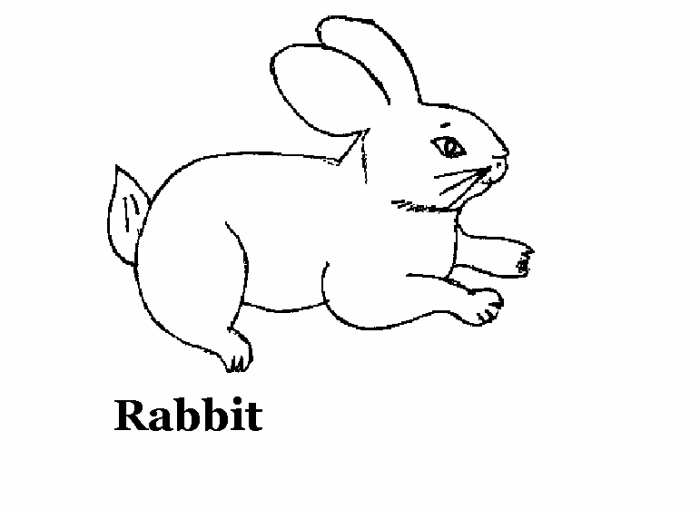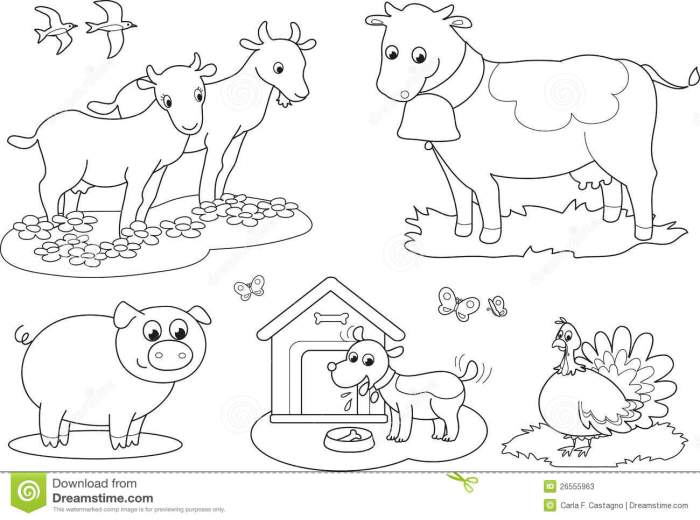Target Audience and Usage

Domestic animals coloring pages – Domestic animal coloring pages cater to a diverse audience, each benefiting from the activity in unique ways. Their versatility extends beyond simple leisure, encompassing educational and therapeutic applications. Understanding these diverse uses and the corresponding design considerations is crucial for maximizing the impact of these coloring pages.The primary purpose of domestic animal coloring pages is to provide a creative outlet, but their applications are multifaceted and depend heavily on the intended user.
Target Audiences for Domestic Animal Coloring Pages
Domestic animal coloring pages are designed to appeal to a range of age groups and individuals with varying needs. Children, particularly preschoolers and elementary school-aged children, represent a significant portion of the target audience. However, adults also find value in coloring, using it as a stress reliever or a creative hobby. Furthermore, therapists often utilize coloring pages as tools in therapeutic interventions.
The design and complexity of the coloring pages will vary greatly depending on the intended user.
Uses of Domestic Animal Coloring Pages
Domestic animal coloring pages serve multiple purposes. They can function as educational tools, introducing children to different animal breeds and species. They can also serve as therapeutic activities, providing a calming and focused experience for individuals managing stress, anxiety, or other mental health challenges. Finally, they can simply be used as a leisure activity, offering a relaxing and enjoyable pastime.
The gentle strokes of crayons on paper, bringing to life a playful puppy or a contented cat – that’s the charm of domestic animal coloring pages. But the therapeutic power of coloring extends beyond childhood; for a more rugged approach, check out the detailed designs in animal coloring pages for men , offering a different kind of creative outlet.
Then, return to the peaceful world of domestic animals, perhaps a fluffy kitten or a loyal dog, and find your own calm amidst the colors.
Design Features Across Different Age Groups
The design features of coloring pages are significantly influenced by the target age group. Coloring pages for young children (ages 2-5) typically feature large, simple shapes and bold Artikels, focusing on basic animal forms with minimal detail. Coloring pages for older children (ages 6-12) incorporate more intricate details, potentially including textures, patterns, and more realistic animal representations. Adult coloring pages often feature highly detailed and complex designs, incorporating patterns and mandalas that provide a more challenging and meditative coloring experience.
Examples of Usage in Different Settings
The application of domestic animal coloring pages extends to various settings.
- Classrooms: Teachers can use coloring pages to supplement lessons on animals, encouraging creativity and reinforcing learning. A lesson on farm animals, for example, could be enhanced with coloring pages featuring cows, pigs, sheep, and chickens.
- Therapy Sessions: Therapists utilize coloring pages as a therapeutic tool, promoting relaxation, self-expression, and fine motor skill development. The act of coloring can be particularly beneficial for individuals experiencing anxiety or trauma.
- Homes: Coloring pages provide a fun and engaging activity for children at home, fostering creativity and imaginative play. Parents can use them as a tool to bond with their children, spending quality time together in a relaxing activity.
Illustrative Examples and Descriptions: Domestic Animals Coloring Pages

This section provides detailed descriptions of three example coloring pages, each featuring a different domestic animal and employing a distinct artistic style. These examples illustrate the range of design approaches suitable for various age groups and skill levels. The descriptions highlight key design elements and their rationale.
Cat Coloring Page Design
This coloring page features a playful tabby cat in a sitting position. The cat is depicted in a slightly cartoonish style, with exaggerated features such as large, expressive eyes and a slightly chubby body. The design incorporates simple, bold Artikels to ensure easy coloring for younger children. The fur is represented by a series of short, curved lines, creating a textured effect without overwhelming detail.
Negative space is used effectively to define the cat’s form and create visual interest. The background is left blank to allow for creative freedom in coloring. The intended audience is children aged 4-7 years old.
Description of Cat Coloring Page: A charming, simplified depiction of a tabby cat, suitable for young children. The design prioritizes ease of coloring with bold Artikels and simple fur texture representation. The blank background encourages creative expression.
Dog Coloring Page Design, Domestic animals coloring pages
This coloring page showcases a realistic portrayal of a Golden Retriever. The focus is on achieving a high level of detail in the fur texture and facial features. The fur is rendered using a variety of line weights and shading techniques to create depth and dimension. The individual hairs are subtly suggested through short, overlapping strokes, creating a sense of movement and fluffiness.
The facial features are meticulously detailed, including the eyes, nose, and mouth, which are rendered with careful attention to anatomical accuracy. The dog’s posture is natural and relaxed, conveying a sense of calm and friendliness. The intended audience is older children and adults who enjoy detailed coloring projects.
Description of Dog Coloring Page: A realistic depiction of a Golden Retriever emphasizing detailed fur texture and anatomical accuracy. This design is suitable for older children and adults seeking a challenging and rewarding coloring experience.
Bird Coloring Page Design
This coloring page features a brightly colored parrot perched on a branch. The design employs simple, bold lines and large areas of color. The bird’s shape is defined by basic geometric forms, making it easy for young children to trace and color. The feathers are suggested through simple lines and patterns, avoiding complex details. Bright, primary colors are used to create a visually appealing image.
The branch is rendered with equally simple lines. The overall design is clean and uncluttered, allowing children to focus on the act of coloring without being overwhelmed by intricate details. The intended audience is children aged 2-5 years old.
Description of Bird Coloring Page: A simplified, brightly colored parrot design ideal for very young children. The use of basic shapes and bold lines makes it accessible and encourages creative color choices.
Educational and Therapeutic Applications

Domestic animal coloring pages offer a versatile tool with significant potential for both educational and therapeutic applications. Their engaging nature can be leveraged to foster learning and promote well-being in children. The visual appeal of these pages, coupled with the act of coloring itself, creates a multi-faceted approach to skill development and emotional regulation.
Teaching Animal Breeds and Characteristics
Coloring pages featuring various domestic animal breeds provide a visually engaging method for teaching children about animal diversity. For instance, a page depicting a German Shepherd can be accompanied by facts about the breed’s origin, temperament, and physical characteristics. Similarly, coloring pages showcasing different cat breeds—such as Siamese, Persian, or Maine Coon—can highlight variations in coat length, eye color, and body type.
Children can learn to differentiate between breeds through observation and the act of recreating these differences through color and detail. This approach combines visual learning with factual information, reinforcing knowledge retention.
Incorporating Coloring Pages into Therapeutic Activities
The act of coloring has been shown to have a calming effect, reducing stress and anxiety. Domestic animal coloring pages, with their appealing subjects, can be particularly effective in therapeutic settings. The repetitive nature of coloring can be meditative, allowing children to focus on a single task and momentarily escape anxieties. The creative freedom offered by choosing colors and adding details allows for self-expression and emotional release.
Therapists can utilize these pages as a tool to facilitate discussions about emotions, coping mechanisms, and self-regulation. For example, a child might be encouraged to choose colors that reflect their current mood, providing a non-verbal way to communicate feelings.
Improving Fine Motor Skills and Hand-Eye Coordination
Coloring pages contribute significantly to the development of fine motor skills and hand-eye coordination. The precise movements required to stay within the lines, color accurately, and add details enhance dexterity and control. Children learn to manipulate coloring tools with increasing precision, improving their ability to perform tasks requiring fine motor control. This skill development extends beyond coloring, benefiting handwriting, drawing, and other activities requiring manual dexterity.
The visual feedback provided by the coloring process allows children to immediately see the results of their efforts, fostering a sense of accomplishment and encouraging continued practice.
| Educational Application | Therapeutic Application |
| Teaching children about different animal breeds (e.g., distinguishing between a Labrador Retriever and a Golden Retriever through visual cues and accompanying facts). | Providing a calming activity to reduce stress and anxiety, allowing for self-expression and emotional release. |
| Reinforcing learning through visual association; for example, coloring a cat and simultaneously learning about its characteristics (e.g., whiskers, paws, etc.). | Using coloring as a tool for emotional regulation and communication; for instance, choosing colors to reflect mood or feelings. |
| Encouraging observation and detail-oriented learning by focusing on specific animal features (e.g., coat patterns, markings). | Facilitating discussions about emotions and coping mechanisms within a therapeutic setting. |
